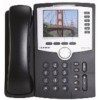Cisco SPA962-NA Administration Guide - Page 24
Technology Background, Session Initiation Protocol, Using 900 Series Phones with a Firewall or Router
 |
View all Cisco SPA962-NA manuals
Add to My Manuals
Save this manual to your list of manuals |
Page 24 highlights
Technology Background Chapter 1 Introducing Linksys 900 Series IP Phones Technology Background This section provides background information about the technology and protocols used by the ATA. It includes the following topics: • Session Initiation Protocol, page 1-12 • Using 900 Series Phones with a Firewall or Router, page 1-12 • Using 900 Series Phones with a Firewall or Router, page 1-12 Session Initiation Protocol Linksys 900 Series IP phones are implemented using open standards, such as Session Initiation Protocol (SIP), allowing interoperation with all ITSPs supporting SIP. Figure 1-2 illustrates a SIP request for connection to another subscriber in the network. The requestor is called the user agent server (UAS), while the recipient is called the user agent client (UAC). Figure 1-2 SIP Requests and Responses SIP UA 2 4 SIP Proxy RTP 3 1 SIP Proxy SIP Proxy SIP UA In a SIP VoIP network, when the SIP proxy receives a request from a UAS for a connection and it does not know the location of the UAC, it forwards the message to another SIP proxy in the network. Once the UAC is located and the response is routed back to the UAS, a direct peer-to-peer session is established between the two UAs. The actual voice traffic is transmitted between UAs over dynamically assigned ports using the Real-time Protocol (RTP). Using 900 Series Phones with a Firewall or Router When using a 900 Series phone behind a firewall or router, make sure that the following ports are not blocked: 1-10 Linksys 900 Series IP Phone Administrator Guide Document Version 3.0















